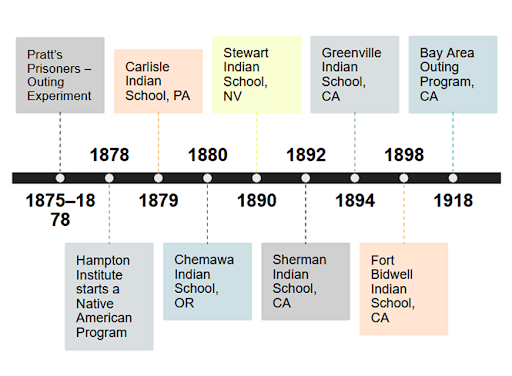Overview
Free Resources!
National Policy: Indian Boarding Schools in California

Author: Caitlin Keliiaa, PhD (Washoe, Paiute)
Lesson partner: Rebecca Lowry and Maggie Peters, Humboldt County Office of Education
Grades: 9-12
Suggested Amount of Time: 1-2 class sessions
Curriculum Themes
- History
- Law/Government
Learning Goals
Students will:
Evaluate Indian Boarding School policy nationally and locally in California
Learn what compulsory “education” was like for Native American children in the late 19th and 20th centuries
Identify key policymakers and officials who created and supported the Indian Boarding School system
Lesson Overview
This unit reviews a brief history of national Indian Boarding School policy and its effects locally in California with particular attention to Sherman Indian School in Riverside, CA. Students will engage in a Think – Pair – Share activity, will learn about the creation of the first off-reservation boarding school, and see a timeline of western and California-based schools. Students will hear first-hand accounts from federal officials and learn how boarding schools prioritized gendered labor. At the end of the lesson, students will define key terms and revisit essential questions. Lesson includes references to optional videos and additional materials and resources.
Teacher Background
This lesson is a great addition to lessons on education, segregation and Native American history. Indian Boarding schools have affected generations of Native people in the US—in fact most Native families have had an ancestor who attended one or more of these schools. Further, under the leadership of Secretary of the Interior, Deb Haaland, the Federal Indian Boarding School Initiative sought to further understand the impact these institutions had on Native children and their families.
Prior to this lesson, teachers will need to establish that Native American communities exist in the United States and that many were affected by Indian boarding school policy. Teachers should not discuss Native American people in the past tense. This lesson is best taught in conjunction with lessons around the history of California especially in the late 19th century and early 20th centuries. It may also be taught alongside broader US history and Native American history. Alternatively, it can be taught with lessons that surround Ethnic Studies curriculum including conversations around education, segregation, Native American issues, and people of color.

